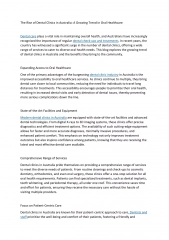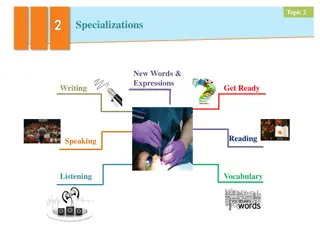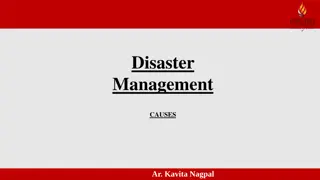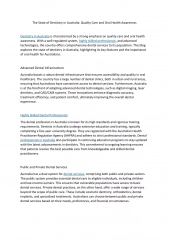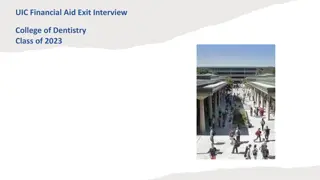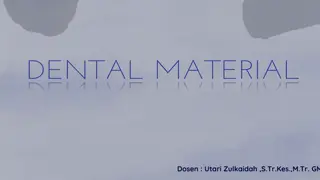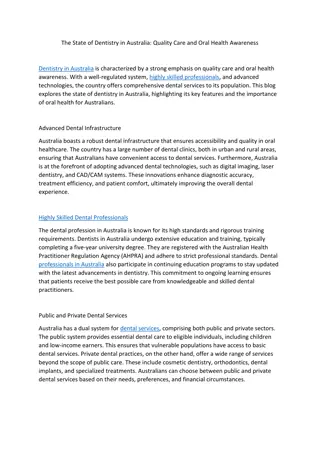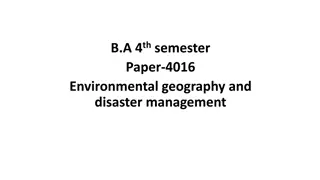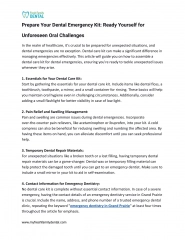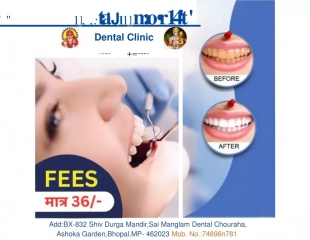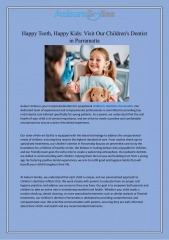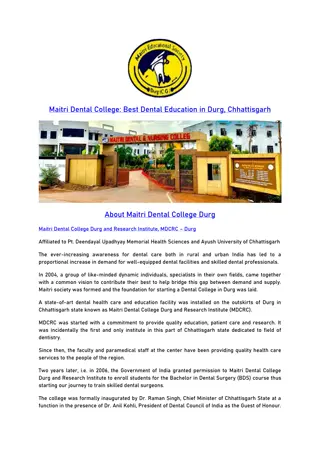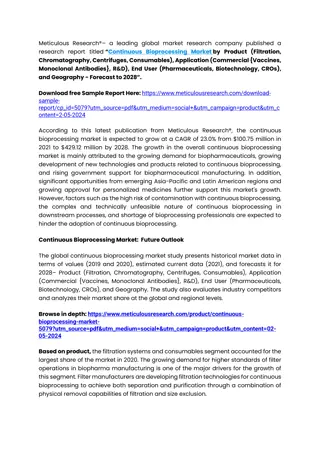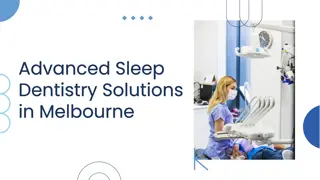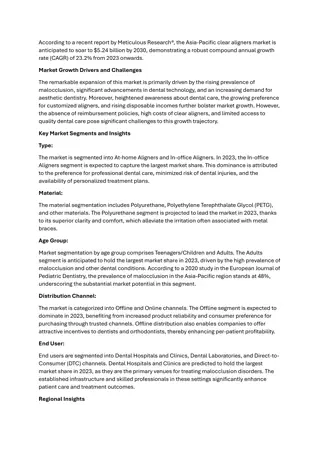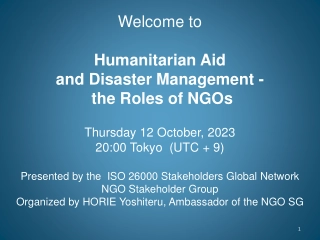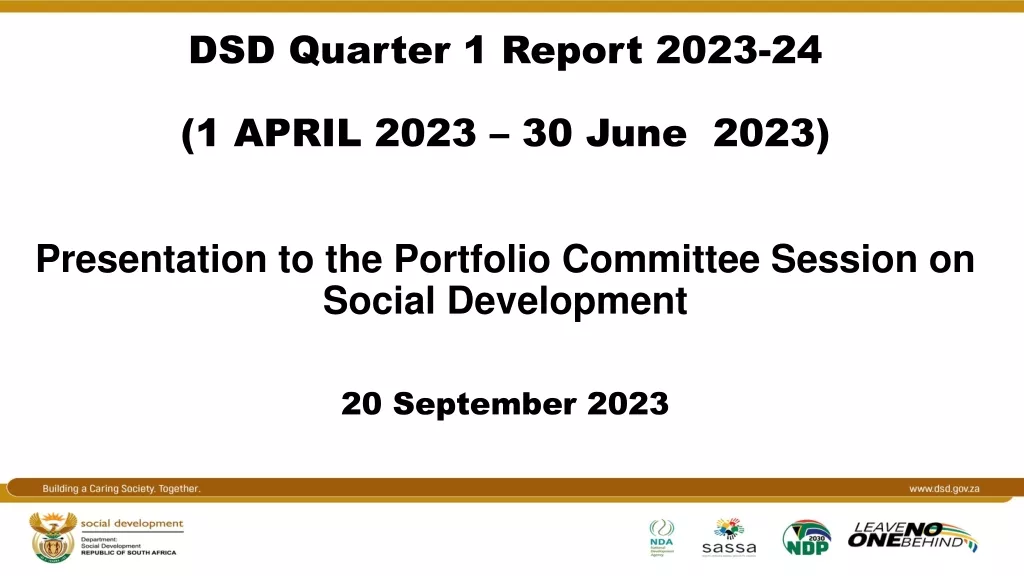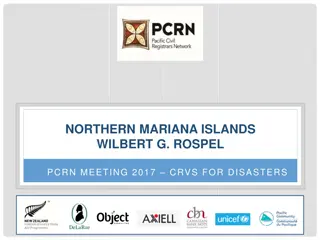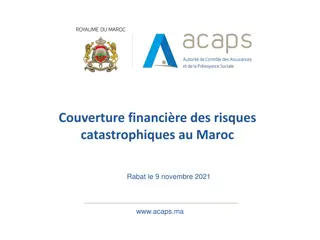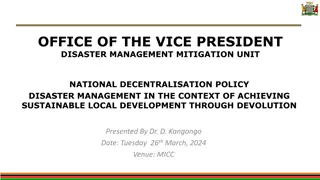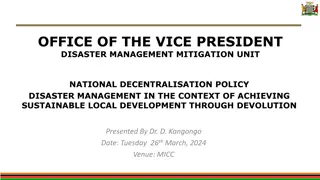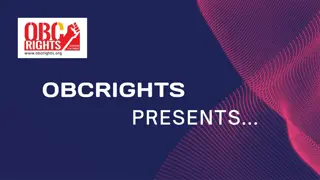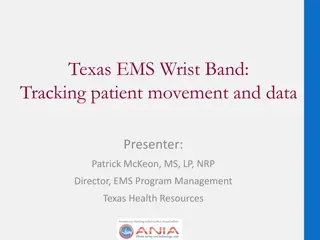Disasters in Dentistry
Learn from Jacqueline Clarke, a Lead Senior Risk Consultant and Dental Claims Consultant at MedPro Group, about managing disasters in dentistry. With a background in law and extensive experience in risk management, she provides valuable insights and strategies for dentists to navigate unexpected challenges effectively.
Disasters in Dentistry
PowerPoint presentation about 'Disasters in Dentistry'. This presentation describes the topic on Learn from Jacqueline Clarke, a Lead Senior Risk Consultant and Dental Claims Consultant at MedPro Group, about managing disasters in dentistry. With a background in law and extensive experience in risk management, she provides valuable insights and strategies for dentists to navigate unexpected challenges effectively.. Download this presentation absolutely free.
Presentation Transcript
Disasters in Dentistry What to do when the unthinkable happens January 21, 2024
Speaker Bio Jacqueline Clarke, J.D. Lead Senior Risk Consultant and Dental Claims Consultant, MedPro Group (Jacqueline.Clarke@medpro.com; 248-216-0644) Jacqueline Clarke received her BA in Literature and Film from Kalamazoo College in 2010, and her Juris Doctorate from Michigan State University College of Law in 2013. She is admitted to practice law in both the Michigan and Illinois state courts, as well as the United States District Courts for the Eastern and Western Districts of Michigan. Before joining MedPro Group, she worked as a litigation attorney at Smith, Haughey, Rice & Roegge in Ann Arbor, Michigan. There, she specialized in the defense of hospitals, healthcare facilities, physicians, nurses, and dentists in all stages of the licensing, claims, and litigation processes. She also provided risk management consultative services to a number of institutional clients, including the University of Michigan Health System, Spectrum Health, and Beaumont Health. Jacqueline joined MedPro in 2018 and helped our dental division achieve a trial win rate of 95% and a closed without payment rate over 80%. Jacqueline s responsibilities include developing and delivering risk management and patient safety services to MedPro-insured dentists, students, and national dental organizations. Jacqueline also serves in a business development role by providing educational seminars on risk reduction and proactive risk management to prospective clients, distribution partners and dental students. 2
Disclaimer MedPro commercial interest. It is the policy of MedPro Group to require that all parties in a position to influence the content of this activity disclose the existence of any relevant financial relationship with any ineligible company/commercial interest. When there are relevant financial relationships mitigation steps are taken. Additionally, the individual(s) will be listed by name, along with the name of the commercial interest with which the person has a relationship and the nature of the relationship. Today s faculty, CE planners, content developers, reviewers, editors, and Risk Solutions staff at MedPro Group, have reported that they have no relevant financial relationships with any commercial interests. The information contained herein and presented by the speaker is based on sources believed to be accurate at the time they were referenced. The speaker has made a reasonable effort to ensure the accuracy of the information presented; however, no warranty or representation is made as to such accuracy. The speaker is not engaged in rendering legal or other professional services. The information contained herein does not constitute legal or medical advice and should not be construed as rules or establishing a standard of care. Because the facts applicable to your situation may vary, or the laws applicable in your jurisdiction may differ, if legal advice or other expert legal assistance is required, the services of an attorney or other competent legal professional should be sought. Group receives no commercial support from any ineligible company/ 3
MedPro Dental Highlights Largest Dental Malpractice Insurer #1 National Market Share Owned by Berkshire Hathaway A++ Highest Financial Ratings in Industry Protecting Dentists for over a Century Leading Dental Claims Results ~48K Dentists and Specialists 95% Trial Win Rate Robust Policy 82% Closed w/o Pay Pure Consent to Settle Occurrence 5
Objectives During today's program, we will discuss: The current malpractice environment Common categories of cases Informed Consent Preoperative Errors Intraoperative Errors Postoperative Errors "Disaster" claims in each category Risk management considerations preventing "disaster" claims 6
Today's Malpractice Environment Dental claims frequency is rising after a decade of steady decrease. Dental claims severity is also rising significantly: Average claim in mid-1990s = $19k. Average claim in mid-2000s = $39k. Average claim today = $90k. Social inflation is contributing to the severity trend. Plaintiff Attorneys are focusing on the service side of dentistry, to push the severity trend. 8
Reasons for Today's Malpractice Environment Practicing Beyond Abilities Patient / Juror Expectations Societal View of the Legal + Medical Systems Societal View of a Dollar's Worth Consumer Culture patient as a buyer of a service Work/Debt Conundrum Red Flag Patient Groups 10
Professional MalpracticeDefinition When a medical professional provides care that diverges from what is accepted as the standard of care as recognized by the medical community, which directly causes damages. 12
Informed Consent [or lack thereof]
Informed Consent Errors Occurs due to: Poor Communication Clerical Error Patient Selection Examples: Failure to disclose particular risks of the procedure; Failure to tailor consent to the individual patient; Failure to advise patient of alternatives to treatment (e.g. RCT vs Extraction); Clerical error getting consent for the wrong patient or procedure 15
Minimum Disclosures + The Informed Consent Discussion The patient's current condition? The proposed intervention / treatment options? (both in medical and layman s terms) Explanation of the purpose of the procedure Important risks & benefits (those the patient may consider important & those that may affect the patient s decision to accept/reject the recommendation) Failure to cover any of these disclosures, or failure of the patient to understand any of these disclosures, may set the stage for a subsequent malpractice action. Risks if the treatment not undertaken Alternatives to the proposed procedure/treatment, including no action Expected outcomes This duty is non-delegable. The patient squestions and understanding of the proposed plan 16
Informed Consent & DocumentationA Good Example Risks of Suggested Treatment Condition & Suggested Treatment Options in Compromise Patient Education Patient Desires 17
Customized Consent Patients cannot make an informed decision about their own risks or benefits with any given therapy based solely on population-wide data. They need estimates based on their own unique characteristics. 18 Miller, R. (2011, November 15). Customized informed consent improves communication. Medscape. Retrieved from www.medscape.com/viewarticle/753598
Case Study #1: Informed Consent 30-year-old male professional trumpet player had an asymptomatic deep vertical FBI #32 and a perio defect distal to #31. Patient A PA showed the M root within 2-3mm of the IAC. The practitioner's assistant discussed the risks, benefits, and alternatives, and also advised the patient of the risk of paresthesia. The patient was provided with a consent form. He signed the form, although he admitted he did not read it. The surgery was uneventful. #32 was sectioned, and the roots were removed. Summary Outcome After 1 week, the patient was found to be numb over the V3 distribution. He was "slightly less numb" at the 1 month visit. He was referred to an OMFS after 6 months. The Problem: Because the patient was numb, he could not embouchure to play the trump, and could not return to his career. Issues? 19
Case Study #1: Informed Consent Other Tx Options Extent of Discussion #32 was asymptomatic when the patient presented did the tooth need to be extracted? The informed consent discussion was done by the dentist's assistant (non-delegable). A performed. coronectomy could have been The patient's profession as a trumpet player was not taken into consideration there was no specific discussion with him about how an injury could impact his career (no embouchure warning). The patient's claim that he did not read the informed document? consent 20
Informed Consent Risk Tips Adequate and effective informed consent is a process, not merely a form. Proper implementation of the informed consent process helps engage patients in their care and should be viewed as a tool that supports shared decision-making. The "teach-back" method can help gauge patient comprehension of information received during the informed consent process. 21
Preoperative Treatment Error Surgical Errors
Preoperative: Surgical / Treatment Errors Occurs due to: Poor pre-procedure planning; Practicing beyond one's ability; Poor communication; Clerical errors in communication Examples: Extraction of the wrong tooth; Perforation of a root during a root canal; Wrong-sided surgery; Inadvertent placement of implant in IAN canal space; and Severing or otherwise injuring a nerve (IAN, LN) during third molar extraction 23
Case st dicates Case Study #2: Preoperative Treatment Errors: Surgical Pre-Op Patient 70 YOF former attorney, C, presented to her general dentist for a cleaning. Her general dentist noted an area of abnormality along the buccal gingival margin of #18 and #19 on the left side of C's mouth. He referred her to a periodontist. Summary Periodontist biopsied the area, and sent the biopsy to pathologist. Pathologist returned a temporary dx of "atypical epithelial proliferation" but advised he needed a larger tissue sample. He sent a note to the periodontist. The Perio re-examined C and took another biopsy. His chart note read: 24
Case st dicati3s Case Study #2: Preoperative Treatment Errors: Surgical Pre-Op Summary The Perio's requisition form to the pathologist reads: The Perio wrote a referral to an OMS stating an area of concern around #30 and #31 . The OMFS examined the patient, and noted an abnormality on the left side of the patient s mouth. The OMFS scheduled the patient in hospital for a limited marginal mandibulectomy including a modified radical neck dissection . 25
Case st dicati3s Case Study #2: Preoperative Treatment Errors: Surgical Pre-Op Summary On day of surgery, C was examined by the anesthesia team. They began examining the R side of her face. C explained they had the wrong side and surgery was to be performed on her L side. The Anesthesiologist noted the chart as to his conversation with the patient. The OMS did not speak with the patient beforehand. Intraoperatively, he prepared the right sideof the patient s mouth. The OR team stopped the OMSS, and stated per the patient and the Anesthesiologist, this was the wrong side. The OMS reviewed: (1) the referral from the Perio, (2) the second pathology report. 26
Case st dicati3s Case Study #2: Preoperative Treatment Errors: Surgical Pre-Op He then does this: 27
Case Study #2: Preoperative Treatment Errors: Surgical Pre-Op No documented instances by insured or his staff to follow-up with the patient when he missed appointments. Poor Team Communication Pre-Op System Documentation Error Clear his Failure subsequent Multiple studies show the quality of team communication directly impacts the clinical outcomes of patients Make it easier for staff to speak up implement a critical language policy 28
Case Study #2: Preoperative Treatment Errors: Surgical Pre-Op Poor Team Communication Pre-Op System Failure No pre-op site verification by OMS Good directly impacts the clinical outcomes of patients. Team Communication Time-Out Protocol Make it easier for staff to speak up implement a critical language policy When in doubt . . . stand still 29
In Summary The performance of dental procedures on the wrong teeth most commonly occurs due to miscommunication, clerical errors, and dentist oversight. In many cases, dentists fail to recognize they have rendered treatment on the incorrect tooth, which can further anger patients, and increase litigiousness. Preventative measures, including pre-procedure time-outs can reduce the potential for performing work on the wrong tooth. Independent evaluation of symptoms and patient complaints as well as informed consent confirmation from the patient can serve as a defense in a wrong-tooth case. 30
Intraoperative Errors Anesthesia
Intraoperative Errors Occurs due to: Poor patient selection Poor management of the patient intraoperatively Communication Errors Examples: Failure to properly does anesthetics; Failure to monitor during anesthesia; Failure to recognize signs + symptoms of distress; Failure to timely intervene; and Failure to timely complete an anesthesia record 32
Case Study #3: Intraoperative Treatment Errors: Anesthesia 18 year-old patient, J, with history of nonverbal cerebral palsy and seizure disorder brought to insured, K, for dental treatment under anesthesia. Patient J underwent treatment with Dr. K and a team of two residents at a local hospital. J received an IM injection of Ketamine 200 mg. He was then nasally intubated with a size 5.5 tube in his R nostril; the tube was uncuffed. The patient was administered the following: Ketamine 200 mg, Midazolam 5 mg; propofol 3000 mg on infusion pump; dexamedomidine 8 mcg, remifentanil 280 mcg The team then performed 18 composites and 2 extractions. Summary Intraop Course During procedure, J's pulse ox, BP, heart rates, and end tidal Co2 were monitored constantly. Hours into the procedure, Resident A noted there appeared to be a desaturation. Dr. K was not in the room, and Resident A went to get him. Dr. K scoped the patient, and saw nasal tube was slightly out of trachea. He re- inserted it promptly without issue. 33
Case Study #3: Intraoperative Treatment Errors: Anesthesia The anesthesia record was not charted contemporaneously with treatment. Dr. K's reintubation attempt, including how long it took, was not charted. Records The EKG machine was turned off at 5:05 pm. The Residents allowed J's father to come into the surgical suite and cut J's hair and nails. Anesthesia was then discontinued at 5:50 pm. Upon extubating the patient, Resident A noted there appeared to be blood in the ET. End of Tx J was monitored in the PACU for 70 minutes. Dr. K gave J's dad post-op instructions. He did not tell J's father re: the desaturation episode that happened intraoperatively. J's father took J home. The next day, Dr. K received a call from J's dad indicating J had desaturated at home, and had died. PACU Issues? 34
Case Study #3: Intraoperative Treatment Errors: Anesthesia ET Tube Not Cuffed Uncuffed tubes prone to migration especially in long procedures. Anesthesia Record-Keeping Need to have all vitals charted; Tip: Deflate balloon cuff to prevent necrosis If there is a change in BP, O2 sats, RR, or HR, records need to indicate: Intervention type How long it took to take intervention Result of intervention attempts Clinical Notes & Electronic Tracings must match Changes to Anesthesia Chart Document when changes made and why "Blood in ET Tube" . . . Need f/u 35
Case Study #3: Intraoperative Treatment Errors: Anesthesia Preop Clearance Consider "red flag" patients, or patients with comorbidities. No Notation re: Catheter Need to know fluid input/output especially during long procedures Does PCP know exactly the procedure the patient will undergo. No indicia whether temperature being taken important when coupled with no fluid data. J's father was not told about the desaturation episode, and s/s of future episodes to watch for at home. 36
Post-Treatment Errors Failure to Follow-Up
Postoperative Errors: Failure to Follow-Up Occurs due to: Poor patient communication Poor management + office follow-up systems Clerical error Examples: Failure to detect + diagnose oral cancer; Failure to detect + diagnose nerve injury; Failure to timely diagnose a mandibular fracture; Failure to recognize signs + symptoms of an infection and refer patient for antibiotics or refer patient on for future treatment; and Failure to f/u on ordered labs + imaging. 38
Case Study #4: Postoperative Errors: Failure to Follow-Up 52 YOF M presented to Dr. A with diffuse pain around #31. Patient Dr. A examined M and performed a full clinical evaluation. Symptoms were localized and severe to #31. Dr. A recommended a RCT, and M agreed. During the RCT, Dr. A found vital tissue within the tooth, and did not prescribe abx. Dr. A discharged M, and made a follow-up appointment for 1 week later. 2 days later, M called Dr. A's office in extreme pain. The call went unanswered. A day later, M called again + spoke with Dr. A's assistant, T, and told her Tooth #29 was also in pain, and he was having jaw swelling. T said she would speak with Dr. A and call M back. Dr. A advised he thought #31 was having a "flare-up" and called in a prescription for Pen VK (for possible infection) and Medrol (for inflammation). T called M back and relayed in information. M asked T if Dr. A was available to speak, and T advised "not today." A day later, T presented to the ER with extreme pain. He was diagnosed with a necrotizing fasciitis that required multiple surgical debridement, and an extensive hospitalization. Summary Outcome 39
Case Study #4: Postoperative Errors: Failure to Follow-Up Pre-Op Abx Prescription Judgment call Patient's call to the office: A cc: swelling, but he was (a) never told to come in; (b) not asked about extent of swelling or location. A should have been told to come in when he cc: swelling. Dr. M never called A back to check in. Should never have given Medrol as it is a corticosteroid + will reduce ability to fight infection. Modern trend is to steer clear of prescribing abx when not warranted. Although follow-up is imperative, setting the foundation through communication can keep most of these cases from evolving in the first place good patient 40
Case Study #5: Postoperative Errors: Failure to Follow-Up 40 YOM, S, presented to Dr. M for a prophy visit. Dr. M noted a lesion on the inside of the S's right cheek, and asked if he had been chewing on it. S denied this. Patient Dr. M advised the S he wanted to see him back in 1 month for a recall appointment. S did not return for 3 months. Dr. M observed there was still a slight abnormality on the inside of the cheek. Advised S to return in 1 month. Dr. M intended to biopsy the area if the S returned with an abnormality. S did not return for 1 year and 7 months. When S did return, he complained of pain in his jaw and in his gums. Dr. M observed a more prominent lesion on the inside of the S's cheek, and took a biopsy. Summary Outcome S was diagnosed with squamous cell carcinoma of the jaw, requiring a hemimandibulectomy, bone grafting from his leg, chemotherapy, and radiation. S has had two subsequent reoccurrences of his cancer. Issues 41
Case Study #5: Postoperative Errors: Failure to Follow-Up Follow-Up Undocumented Follow-Up Needed Yes, the patient delayed in following up with insured because of travel. No documented instances by insured or his staff to follow-up with the patient when he missed appointments. his subsequent But given the abnormality observed, it was incumbent to the insured to: Explain why the patient needed to follow-up, and Call the patient when he did not return and advise him to follow-up. Had the patient followed-up as necessary, it is likely the lesion could have been resected using less invasive means 42
What is different about Post-Op Systems Failure Cases: More About: Communication between patient/family and dentist/staff Communication among providers Failure/delay in obtaining consult/referral Lack of/failure in patient follow-up system Expert testimony at trial is less important Less About: Patient assessment issues Clinical interpretation of dx studies Clinical failures 43
Follow-Up System Failures: Risk Considerations No news is NO NEWS. Utilize your patient as your last line of defense Practice needs to take responsibility and set communication + appointment follow-up's. Try to stay away from: If you haven t heard from us by Staff engagement and responsibility is imerpative But all "negatives" must be brought to dentist's attention; no medical/dental advice from staff to patient EVER! 44
Your Malpractice Carrier How it can (should) help
How Your Malpractice Carrier Should Help Team Approach The Insured, Claims Consultant, Risk Consultant, and Defense Attorney should all work collaboratively. Frequent communication with insureds about what is in their best interests Pure Consent Clause available in policies for settlement. Communication Risk Opportunity for additional training, CE's, and individual Q&A sessions with member of our Risk Team. Strong risk-benefit analysis to make informed decisions regarding settlement versus trial Paying the reasonable value of the case; not overpaying just to dispose of the case Claims 46
Malpractice Insurance: What Should I Look For? Strength Financial Health + Ratings Coverage Know what you are purchasing - Claims Made vs. Occurrence - Consent to Settle On-Site teams with depth + experience Ability to discuss w/ experts in real-time + developing situations Expertise in nationwide defense counsel Risk & Claims Avoid sacrificing quality for cost Price 47
@MedProDental dental@medpro.com | 800.4MEDPRO | medpro.com/dentists Jacqueline Clarke, Esq. 248-216-0644 Jacqueline.Clarke@medpro.com 48



